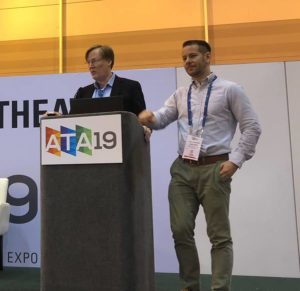
Dr. Rajeev Ramchand at the American Telemedicine Association conference.
Rajeev Ramchand, CVN’s Senior Vice President of Research, has been studying suicide and suicide prevention for over a decade. One area of this research has focused on crisis hotlines, arguably the backbone of America’s suicide crisis response system. For example, he led work that conducted live monitoring of calls made to crisis lines in California, interviewed call responders to learn from them insights about women veteran callers, and conducted an assessment of the architecture of the crisis system with a focus on California. The deaths of fashion designer Kate Spade and chef Anthony Bourdain in June 2018, and the promulgation of the number for the National Suicide Prevention Lifeline (NSPL) in the media coverage that followed, led him and his colleagues to ask: is there an increase in demand for crisis services after celebrity deaths, and is the crisis system equipped to respond? Since data was not readily available for 2018, they looked in the past to when entertainer Robin Williams ended his life in 2014. The results of their study were recently published in the peer-reviewed journal Psychiatric Services. Rajeev shares some insight into the research:
Why did you want to study celebrity suicides, specifically?
I honestly can’t take the credit for this work – it was a collaborative effort. Prior to joining CVN I was working at both the National Institute of Mental Health (NIMH) and RAND. I started working on this paper then, and I collaborated with outstanding colleagues from NIMH, the Suicide Prevention Resource Center (SPRC), Suicide Awareness Voices of Education (SAVE), and the National Suicide Prevention Lifeline (NSPL).
Increases in suicides after celebrities take their lives is a known phenomenon that has resulted in guidelines for how such suicides should be reported on in the media to avoid contagion. One of the recommendations is to provide resources, including the number for the NSPL and other helpful websites like those of SPRC and SAVE. If media is providing this information, it is reasonable to expect an increase in demand for these services. We wanted to estimate whether this occurred, and the capacity of the system to meet this increased demand.
Were you surprised by any of the findings?
We found that calls to crisis lines increased by as much as 300% in the day after the death and slowly dropped in the proceeding days. While crisis line staff were able to respond to some of this increased demand, only 57% of calls were answered the day after Mr. Williams died.
Unfortunately, I wasn’t that surprised by the results. My past research experience on the infrastructure supporting suicide crisis lines revealed how fragile and under-resourced the system is. Crisis lines often rely on shoestring budgets with funding cobbled together from federal, state, and local resources, along with private foundations. Many can only survive by relying on trained volunteers to answer the phone. But while I wasn’t necessarily surprised, my colleagues and I knew that this information was critical to get out to the public.
What are the implications of this study?
We’re at a critical juncture to really rethink the nation’s approach to responding to suicidal crises and our investment in crisis services. Last summer, legislation was passed requiring federal agencies to investigate the feasibility of making crisis mental health care more available through an “N11” telephone number and to analyze the effectiveness of the NSPL. We hope the results from this paper can inform this federal investigation. Fortunately, if we collectively decide to take this on, guidelines exist for strengthening the nation’s crisis system. The nation’s private-public partnership for suicide prevention, the Action Alliance, has a Crisis Services Task Force that recently published Crisis Now: Transforming Services is Within Our Reach, a report that provides solid recommendations to improve the care available for struggling individuals.
